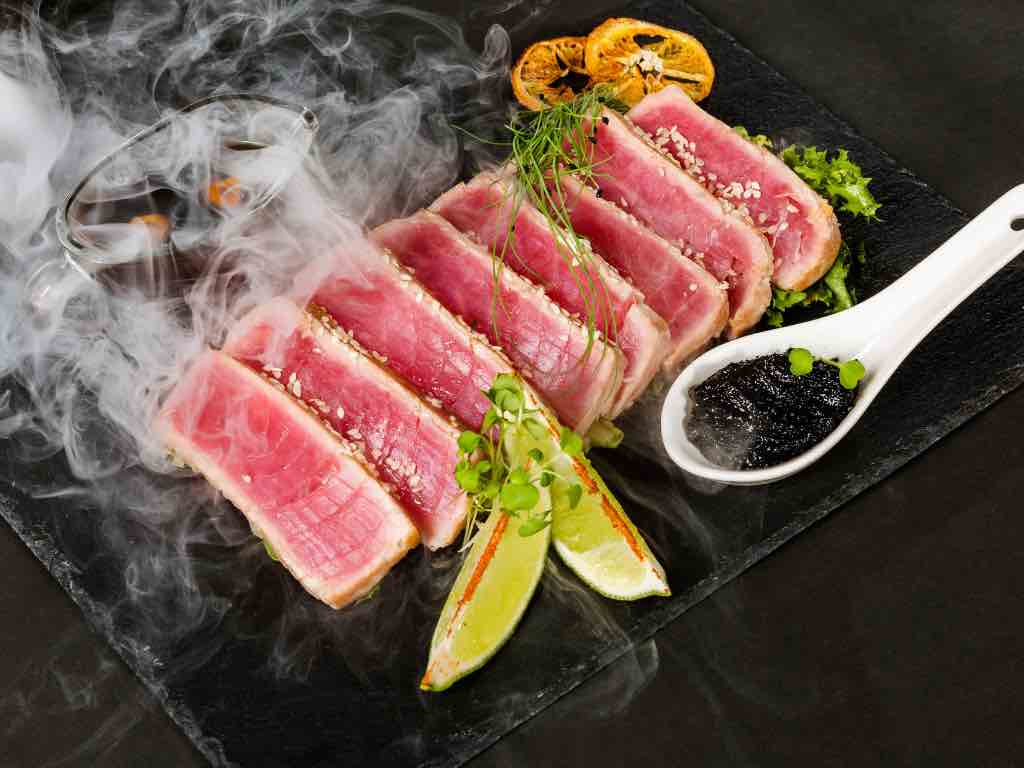If you’re a steak enthusiast, you might occasionally crave a break from traditional cuts. Enter tuna steak – seared to perfection, with a savory, meaty flavor and a hint of sweet freshness. Cooking a tuna steak is an art, and we'll explore the science behind it to ensure you achieve the perfect sear and rare interior.
When cooking a tuna steak, understanding thermal principles is crucial. With a quality tuna steak and a reliable thermometer, you can recreate a high-end restaurant dish effortlessly.
What Happens When You Cook a Tuna Steak
Tuna, often associated with canned varieties, is a prized fish with a rich history dating back to the Roman Empire. Tuna steaks, usually from bigeye, ahi or yellowfin tuna loins, offer a delightful culinary experience when cooked properly.
Tuna's myoglobin content, responsible for its meaty color, reacts to cooking temperatures similar to beef. However, tuna's connective tissues are more delicate, making it easier to overcook and lose its appeal.
The Maillard reaction is a chemical reaction between amino acids and reducing sugars that gives browned foods their characteristic flavor. When searing a tuna steak, this reaction contributes to the development of a flavorful crust on the outside.
Should I Use Sushi-Grade Tuna?
All tuna that is high quality and fresh is suitable for raw or rare preparations (sushi-grade). The term "sushi-grade" is not a formal guarantee of quality.
Because almost all fish retailers label their fish "high quality," it is not enough to simply say the tuna at Riviera Seafood Club is high quality as well. Because the quality and freshness of our tuna is leagues ahead of other seafood retailers, there are no other terms to use other than "Sushi-quality" that speak to the quality and freshness of our seafood.
At our facility, we receive the tuna whole, inspect and grade the tuna, then cut to portion. We oversee the entire process under one roof before our tuna gets to your table.
Because we also supply to many other retailers and distributors, we know how much time and how many hands the tuna goes through before it gets to your dinner table if you purchase from them. Without the term "sushi grade," it is difficult for us to convey the quality of our fish otherwise.
FDA Guidelines for Consuming Raw Seafood
The U.S. Food and Drug Administration (FDA) provides guidelines to ensure the safe consumption of raw seafood, particularly addressing the risk of foodborne illnesses.
1. Parasite Destruction
The FDA recommends freezing most fish intended for raw consumption to specific temperatures and durations to destroy parasites. For example, for fish intended for sushi or sashimi, the FDA recommends freezing at -4°F (-20°C) or below for 7 days, or at -31°F (-35°C) or below for 15 hours. Guidelines vary based on the type of fish, however, tuna is exempt from these requirements.
2. Sushi-Grade Label
The term "sushi-grade" doesn't have a specific regulatory definition. It is often used by sellers to indicate that the fish is of a quality suitable for raw consumption. However, the FDA doesn't officially endorse or regulate the term "sushi-grade." Consumers are advised to source seafood from reputable suppliers with good handling practices.
3. Risk Communication
Establishments serving raw or undercooked seafood are advised by the FDA to inform customers about potential risks. This is typically done through menu advisories or verbal communication to ensure customers are aware of the associated risks with consuming raw seafood.
It's crucial to note that these guidelines primarily focus on minimizing the risk of parasites, while proper handling, storage, and refrigeration address concerns related to bacterial contamination, such as Vibrio bacteria.
For the most current and detailed information, it's recommended to check the latest FDA guidelines and regulations, as they may be subject to updates or changes. Additionally, local health departments may have specific regulations that establishments must follow regarding the serving of raw seafood.
Tuna Steak Temperatures
Temperature control is crucial when cooking tuna. While exempt from deep freezing requirements, tuna still requires careful handling to prevent scombroid poisoning. Keep tuna chilled until cooking to minimize the risk.
To avoid overcooking, choose tuna steaks with significant thermal mass, at least an inch thick. High heat is essential for a quality sear, and a cast-iron pan with a light coating of high smoke-point oil works wonders. Preheat your pan or grill to a high temperature, usually around 400-450°F (200-230°C).
Monitor internal temperature closely to achieve the desired rareness. Tuna cooks very quickly, usually just 1-2 minutes per side for a standard 1-inch thick steak. The goal is to sear the exterior while keeping the interior rare or medium-rare which should remain pink or reddish in the center. Although this is a matter of personal preference, tuna is often served rare or medium-rare for the best texture and flavor.
Allow the tuna steak to rest for a few minutes after cooking. This helps redistribute the juices and ensures a more even texture.
On Seasoning Tuna
Tuna steaks often embrace Japanese flavors, but you can experiment with various seasonings. Whether crusted in sesame or seasoned with Mexican-inspired cacao nibs, cinnamon, and black pepper, the key is not to overpower the natural flavor of the tuna.
Tuna can also be marinated before cooking to add flavor. Common ingredients include soy sauce, ginger, garlic, and sesame oil. Keep in mind that acidic marinades can "cook" the fish, so marinate for a short period.

